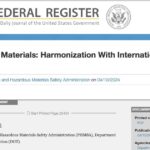On January 8, a 98-car train carrying denatured alcohol, or ethanol, near the Texas—Oklahoma border derailed — 28 of the cars left the track and 25 caught fire.
The derailment happened outside Oklaunion, Texas, which is about 40 miles west of Wichita Falls. The fire burned most of the day, closed portions of a highway and another road, threatened adjoining grassland and required efforts from local fire departments, an Air Force base fire department and BNSF railroad resources.
In the end, there were no reported illnesses or injuries. And the railroad tracks were back in service two days later.
The area is an unincorporated rural area with less than 200 residents and no major waterways. The incident happened near a US 287 overpass, which may have helped responders access the site.
Also Read: 3 Lessons from Recent Train Derailments
“Ethanol is something is a component people use to fuel their vehicles, so it’s burning and it’s not something that hazardous. Thankfully if something like that [explosion] were to happen, it usually happens at the very beginning of this type of incident. That did not occur,” Amy Casas, senior director of media relations of Burlington Northern Santa Fe told KAUZ.
While the risk of explosion was avoided here, ethanol does present fire and hazmat hazards. The grain alcohol, usually made from corn, has a specific gravity of 0.79. Not only is it lighter than water, it will completely mix with water. And it can conduct electricity. Its lower explosive limit to upper explosive limit ranging from 3.3% to 19%. The flashpoint is 55 degrees Fahrenheit. It is heavier than air and carries an OSHA permissible exposure limit of 1,000 ppm, with an immediate danger to life and health at 3,300 ppm.
The biggest threat, or course, is fire. Derailment fires are often left to burn themselves out with water used to cool exposure containers or structures. Here are three tips to improve your hazmat team’s ethanol spill response.
ONE
Have a detailed plan. There’s no need to reinvent the wheel here. Several solid plans exist that can be updated and modified to your jurisdiction. Here’s one from the Franklin Regional Council of Governments. While it is a few years old, it offers a solid framework.
TWO
Know how much foam is available, how far away it is and how long it will take to get it on scene. If the plan is to knock down the fire, only alcohol-resistant foam will be effective. In Oklaunion, responders got help from the U.S. Air Force. Railroads will also be a good resource for fire and hazmat supplies; activate that “ask” soon as supplies may be several hours away.
THREE
Plan for runoff water if there’s fire and for product containment if there’s no fire. Ethanol won’t present a huge environmental threat, but it can still ignite once mixed with water. The water/ethanol mixture can burn with invisible flames, making a TIC a key piece of equipment. Likewise, if foam is used, that runoff will definitely need to be contained. This is where it having up-to-date waterways, storm drainage and sewer infrastructure in the response plan. Ethanol has been known to kill aquatic life and create methane pockets as it dissipates.
Original post – Copyright © 2022 HazmatNation.com. Externally linked references may hold their own independent copyright not assumed by HazmatNation











